Celestron is arguably the best-known manufacturer of telescopic equipment in the world and produces a wide range of scopes to suit all ages and levels of experience. A number of these are designed for both beginners and younger astronomers – and chief among these is the Celestron FirstScope. If you’re looking for your first scope, you might be wondering if this should be your first choice, or if you should invest your money in another?
(If you’re in the market for your first telescope, check out this article on how to buy your first telescope to learn what to look for as well as some valuable buying tips. Not sure what gear you’ll need? Check out this guide on the must-have essential tools for observing the night sky.)
Our Score for the Celestron FirstScope Telescope
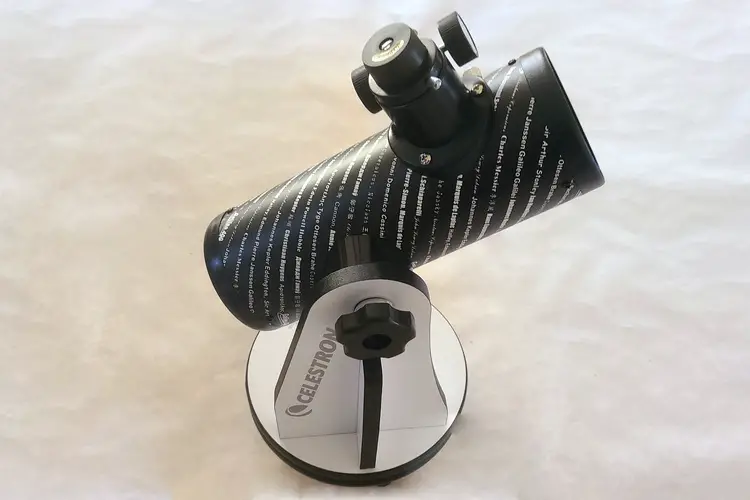 Learn More |
Overall Expert Rating What we like: |
|---|---|
| Ease of Assembly | |
| Ease of Use | |
| Image Quality | |
| Accessories | |
| Value for Money |
All Photos Credit: Richard J. Bartlett
About the Celestron FirstScope Telescope
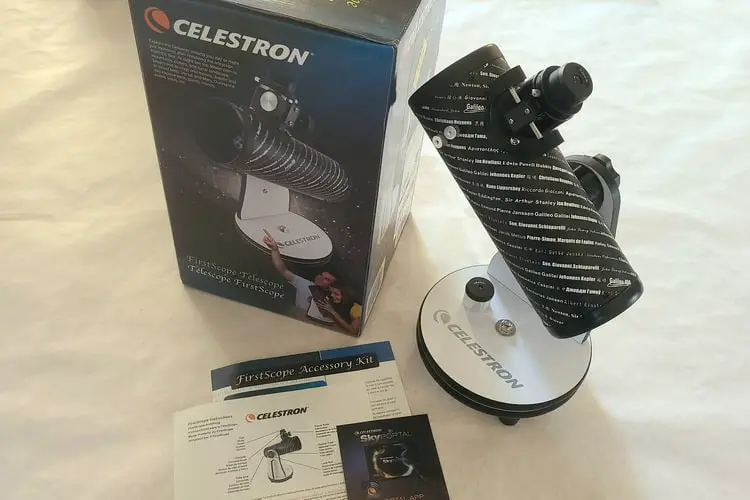
Packaging & Accessories
Celestron always has attractive packaging for their equipment and the FirstScope stays true to that tradition. The box, measuring 9.8 x 9.5 x 15.5 inches and weighing 4.8 pounds, is nicely designed and features photographs and information (in several languages) about the telescope. If you’re buying this for a child, they’re sure to be excited when they open up the gift. The box is also pretty sturdy and should hold up well in transit, even if it’s not inside a larger container.
Besides the FirstScope, you’ll also find the following inside:
- 20mm eyepiece (1.25”, 15x)
- 4mm eyepiece (1.25”, 75x)
- A small cleaning cloth
- Instruction sheet, plus information on their Accessory Kit and SkyPortal app
The scope itself is inside a plastic bag and is held in place by a combination of molded foam and card, while the eyepieces are inside a smaller box.
If you’ve owned a telescope before you might be expecting a bit more, but unfortunately that’s not the case. There’s no finderscope, Barlow lens, lunar filter or smartphone adapter and no free software. While the FirstScope is hardly the most expensive on the market, this seems like cost-cutting to an almost unnecessary extreme.
Quality & Durability
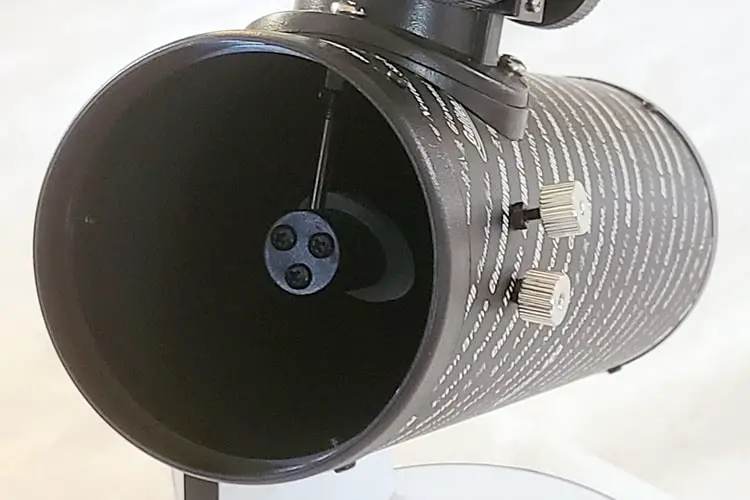
Since the FirstScope has a Dobsonian mount, it has a sturdier, more solid feel than a comparable scope on a tripod. It’s compact, relatively lightweight (weighing just 3.5 pounds, or 1.6kg) and has been designed to be lifted up and carried with one hand. On the whole, the quality of the build is pretty good; the base and the focuser both move smoothly and the optical tube is easily moved up and down without it being too loose.
There’s no easy way to collimate the primary mirror, but given the target audience and its potential uses, this isn’t a huge concern.
In terms of quality, the biggest area of concern lies in the accessories – or lack, thereof. For starters, there’s no finderscope provided with the basic model, and even though the provided 20mm eyepiece produces a low magnification view of just 15x, the lack of a finder is a problem (see Ease of Use below.)
An inexpensive, red dot finder will work just fine, but if you want Celestron’s better quality 5×24 finder, you’ll need to also buy the optional Accessory Kit.
You have two options here; you can either buy the kit separately or buy the FirstScope and kit bundled together. Either way, the total outlay works out about the same.
Another missing essential is a lunar filter. A must-have accessory that’s sometimes provided with some scopes, it attaches to an eyepiece and reduces the light from the Moon, thereby making for a more comfortable viewing experience. Without it, the Moon can be dazzling, and when you’re outside looking at the night sky, you’ll want to keep your night vision.
Again, you can buy the Cometron and filter together or buy the accessory kit separately (the filter is included in the kit), but the filter you’ll get is not the best quality. The reason is that the filter provided is tinted green and the Moon will then appear green as a result. A better option is to buy the Celestron 94105 Neutral Density lunar filter; it costs a few bucks more, but you’ll get a natural color image and it’s also useful for reducing the glare when observing Venus and Jupiter.
Many scopes now also come with a smartphone adapter, which allows you to capture images of the Moon and other bright objects. Again, this is lacking from the FirstScope and from the accessory kit, but can be purchased as a set with the FirstScope or separately.
Unfortunately, this leaves you with the sense that while Celestron are more than willing and able to provide customers with a decent, inexpensive entry-level scope, they also have no qualms in expecting customers to pay extra for the most basic (and essential) accessories.
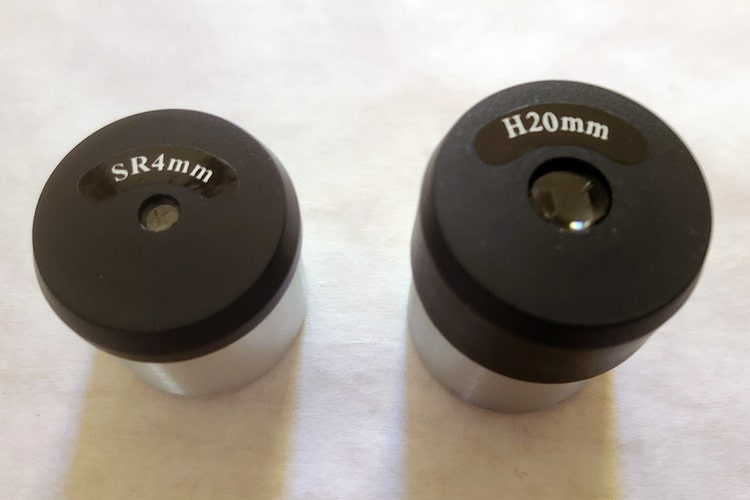
Given the price of the FirstScope, it’s probably too much to expect some decent accessories, and it probably shouldn’t come as a surprise to learn that the provided Kellner eyepieces also leave a lot to be desired. They look and feel plasticky and, frankly, cheap. Celestron used to provide better quality Plossl eyepieces with the FirstScope, but unfortunately, that’s no longer the case.
Inexperienced astronomers or children might not notice, but there are better quality eyepieces available that won’t cost you an arm and a leg. For example, SVBONY produce a range of inexpensive, wide-angle eyepieces, and while they’re probably the cheapest you’ll find anywhere, the quality is still better than the ones supplied with the FirstScope. You can buy a set of three (4mm, 10mm and 23mm) for less than the price of the First Scope itself.
Assembling the Scope
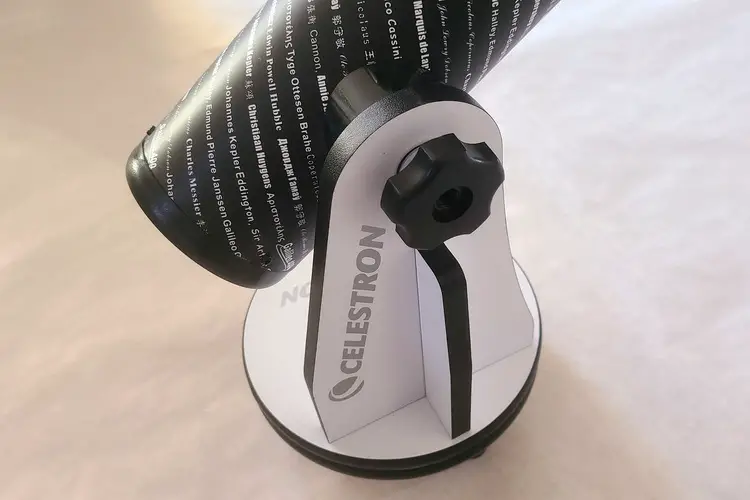
The instructions for the FirstScope – such as they are – can be found on a single sheet of paper included with the telescope. There’s not much to tell here, as the scope comes fully assembled and is pretty much ready to go. That being the case, the top third of one side of the sheet is a diagram of the telescope, with the English instructions taking up another third directly below it. German instructions occupy the bottom third, with Spanish, French and Italian on the back.
To get started, you only need to remove the foam packaging from around the scope and the tape that holds the aperture cover in place. Since there’s no finderscope included, there’s no other assembly required and it only remains for you to remove the cover from the focuser and insert an eyepiece.
There are some straightforward instructions on how to do this for anyone who’s never used a scope before. The instruction sheet also explains how to point the telescope, observe the image correctly and focus the view. There’s also a few brief notes on observing the Moon, planets, deep sky objects, terrestrial objects and optional accessories.
If you need more information, you can download a more detailed version from Celestron’s website, but this should be enough to get you started.
Ease of Use
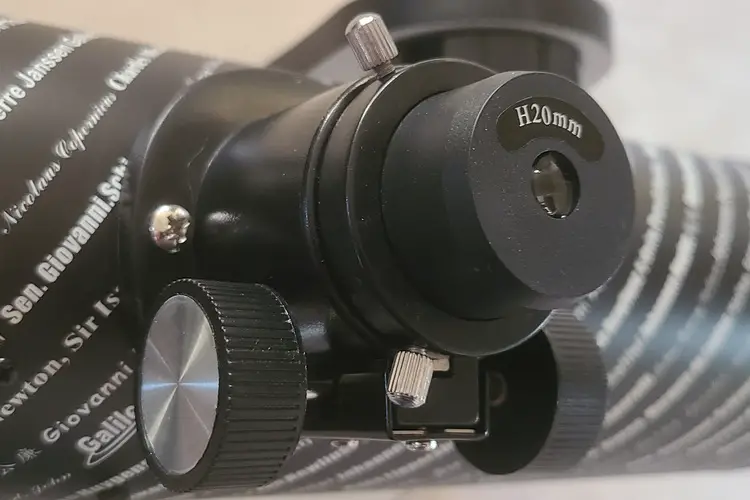
When it comes to the various types of telescope mount, nothing is easier than a Dobsonian. As mentioned before, there’s no set-up required (apart from the addition of any accessories) and the majority of Dobsonians can be easily transported. In this regard, the FirstScope itself is perhaps one of the easiest to use. It’s compact and lightweight enough for an adult to pick up and move with just one hand, but while it’s designed to be accessible to younger children, it’s best if moving the scope is left to the adults.
Once you take the scope outside, you only need to place it on a sturdy, flat surface, such as a table. Since the scope is only a little more than a foot tall, you won’t be able to sit the scope directly on the ground, but that also means you can put it at almost any height, making it possible for almost anyone to use it.
When you’re ready, you’ll need to insert the lowest power eyepiece you have – this will be the eyepiece with the largest number on it. For example, the FirstScope comes with a 20mm and a 4mm eyepiece. The 20mm will produce a magnification of 15x with the FirstScope, while the 4mm will give you 75x, so the 20mm is the one to use.
In the absence of a finderscope, this will help to make it easier to locate your target. And without a finderscope, you’re going to need all the help you can get.
Aiming the telescope is easy enough: you simply turn it to the left and right, or tilt the tube up and down, in order to point it at your target. However, actually getting the target to appear in the eyepiece is another matter.
The instructions state “sight along the Optical Tube towards the object you want to find. Then move the Tube End until you find the object you are searching for and then tighten the Lock Nut.”
You’ll probably need to read it twice, but in essence it translate to “point it at what you want to look at, then move it around until you can see it through the eyepiece.”
This is easier said than done, as you’ll need to look along the telescope tube and try to move it so that your target appears just above the eyepiece. If you’re lucky, your target will then be visible in the eyepiece (or at least just outside the field of view.)
This is doable with terrestrial targets or something large and bright, like the Moon, but not so easy when you’re trying to aim it at a planet, multiple star or even one of the brighter deep sky objects, like the Pleiades. It might be capable of spotting faint galaxies, but without a finderscope, you’ll be stumbling around in the dark.
Performance
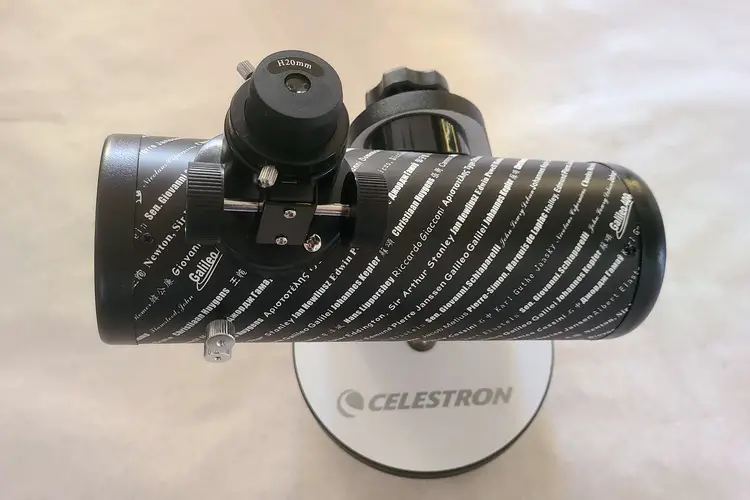
The FirstScope was tested during the day on terrestrial targets and also on astronomical targets at night. The biggest problem, of course, is trying to get your target in the eyepiece in the first place, but once you do, focusing is smooth and produces very little vibration.
(Incidentally, it’s a good idea to take the scope out during the day to practise aligning the scope and focusing the view, especially if the Moon is visible in the sky at the time.)
As expected, neither of the two eyepieces are of any decent quality. Both produced a small field of view with noticeable distortion around the edges. There was also a fair amount of chromatic aberration around the edge of both the field of view and any high contrast targets, such as hills, buildings or even the rising Moon against the blue sky. You’ll also find that’s it’s difficult to focus as the eyepiece seems incapable of producing a sharp view.
However, switch the supplied 20mm eyepiece out for an inexpensive SVBONY 23mm and the view greatly improves. For starters, the field of view is much wider, which makes for a much more comfortable observing experience. Distortion is also greatly reduced, and while there’s a little chromatic aberration still present, it’s not nearly as obvious as before.
Regardless of which eyepiece you use, you’ll also notice a blurry black dot in your field of view. This is the secondary mirror (the smaller mirror near the open end, or aperture of the telescope) reflected in the primary mirror. It’s especially noticeable during the day and can be something of an inconvenience, requiring you to almost literally look around it.
While this is common with reflectors, it seems somewhat conspicuous on the FirstScope and could prove irritating
It’s a little tricky to test a telescope at night without a finderscope. Even a basic red dot finder is better than nothing, but since nothing is what you get, your options are somewhat limited. With practice, you’ll be able to find your target, but (arguably) you shouldn’t have to work that hard in the first place.
There is, however, a silver lining here. As the FirstScope has a short focal length of just 300mm, a 20mm eyepiece will produce a low magnification of 15x (300 / 20 = 15). This is about the same as the magnification produced by astronomical binoculars, which makes it possible to star-hop from a bright star or planet to your desired target.
The FirstScope was tested on the waxing gibbous Moon, the Orion Nebula, the Pleiades star cluster and several double stars. It should be noted that although the supplied 20mm eyepiece was used when observing the Moon, the SVBONY 23mm and 3mm eyepiece was used for all other targets. The 20mm eyepiece had too much of a negative impact on the view to fairly represent the scope’s capabilities.
As noted before, the Moon showed visible chromatic aberration (color around the edges) with the supplied 20mm (15x) eyepiece. It was also difficult to focus, as the eyepiece distorted the view of any object not in the center. The view through the 3mm (100x) was worse as the field of view was also significantly narrower. It almost feels as though you’re looking at the Moon through a magnifying glass at the end of a cardboard tube.
Switching the eyepiece out for the SVBONY 23mm produces a wider, sharper image that puts the supplied 20mm to shame, but the SVBONY 3mm eyepiece didn’t fare as well as its larger cousin. Although the field of view and image was much better than the supplied 3mm, the FirstScope doesn’t do a great job of handling eyepieces with a short focal length. More specifically, focusing was very tricky and felt as though it needed pinpoint precision.
That said, it should work fine if you use an eyepiece with a longer focal length and a barlow. For example, a 10mm and 3x will produce 100x but with better results.
The Orion Nebula looked good with the SVBONY 23mm; the outline of the southwestern edge (the brightest portion) was visible, along with a hint of green and three or four Trapezium stars at its heart. M43 was also very faintly visible.
The Pleiades can always be relied upon to put on a good show, so if the FirstScope didn’t produce a good image of the cluster, it would have been a problem. Fortunately, that wasn’t the case, as the stars appeared sharp and blue, with the occasional white star visible among them.
It was a similar story with Mizar & Alcor, the famous double in the Big Dipper’s handle. The pair are sufficiently far apart to produce an aesthetically pleasing view, while Mizar itself was a close but clean split. Cor Caroli, the brightest star in neighboring Canes Venatici, was also a clean split, with the primary appearing a peachy color and the secondary white.
Lastly, the widest components of the golden double star Algieba in Leo were clearly seen, but the primary star itself was not split, even at 100x.
Target Audience

As the name implies, Celestron’s FirstScope is designed to be a budding astronomer’s first telescope. Its Dobsonian mount makes it quick and easy to set-up and use, and its optics are quite capable of delivering some decent views. This makes it a good choice for younger astronomers, but teens or adults will get more from a bigger scope, such as the Zhumell Z100 or the Sky-Watcher Heritage 130.
Its compact size and weight also make this a good choice for anyone looking for a small scope to take on family camping trips, but not without first investing in some essential accessories. Unfortunately, it’s the lack of accessories (such as the lunar filter, decent eyepieces and finderscope) that let the FirstScope down and could result in the young astronomer becoming frustrated and losing interest.
Specifications
- Type: Newtonian Reflector
- Mount Type: Alt-Azimuth
- Base: Dobsonian
- Computerized or Manual: Manual
- Aperture: 76mm (3.0”)
- Focal Length: 300mm (11.8”)
- Focal Ratio: f/4
- Included Eyepieces: 2
- Eyepiece 1: 20mm (15x)
- Eyepiece 2: 4mm (75x)
- Finderscope: None
- Highest Useful Magnification: 180x
- Lowest Useful Magnification: 11x
- Limiting Stellar Magnitude: 11.9
- Resolution (Dawes): 1.5 arc-seconds
- Optical Coatings: Unknown
- Optical Tube Length: 368mm (14.5”)
- Mount Height: 279mm (11.0”)
- Total Weight (Assembled): 6.2 pounds (2.8 kg)
- Warranty: Two Year Limited Warranty
What We Liked
- Very easy to use
- No assembly required
- Relatively lightweight
- Suitable for younger astronomers
What We Didn’t Like
- No finderscope
- Poor quality eyepieces
Final Verdict
Whether the FirstScope is right for you really depends on who you’re buying it for and how it’s going to be used. If you’re an adult looking for your first telescope with the goal of learning more about astronomy, then this isn’t really for you. It’s simply not powerful enough. If, on the other hand, you just want something small and lightweight you can quickly take outside for an impromptu look at the Moon (or other large, reasonably bright object) then this should work quite well.
Similarly, if you’re looking for a small scope for a younger child, or maybe a portable scope for the family, this could nicely fit the bill. It won’t produce breathtaking views of the planets or magically transport you to the distant realms of the universe, but it can certainly get you on your way. Whatever the reason for your purchase, be sure to buy a finderscope and a lunar filter and, lastly, ditch the eyepieces and replace them with your own.
Recommended Accessories
- Celestron 1.25″ Moon Filter – pretty much an essential accessory, this filter reduces the glare of the Moon and allows you to observe it without being dazzled. It’s also “neutral density,” meaning that it produces a natural color view of the Moon.
- Celestron FirstScope Accessory Kit – worth buying, if only for the finderscope and carry bag, but also includes a lunar filter, plus a 2.5mm eyepiece (120x) and 6mm eyepiece (50x).
- SVBONY Eyepieces (Set of 3) – this inexpensive set includes a 23mm, 10mm and 4mm eyepiece that will produce magnifications of 13x, 30x and 75x respectively.
- Celestron Omni 2x Barlow Lens – a 2x Barlow will double the magnification of any eyepiece you attach to it. It’ll provide magnifications of 30x and 200x if used with the FirstScope and the eyepieces supplied with it.
- Celestron 8mm to 24mm Zoom Eyepiece – avoid having to carry a range of eyepieces with you by using a zoom eyepiece. This eyepiece provides a magnification range of between 13x and 38x when used with the FirstScope.
- Celestron PowerTank Glow 5000 – a red flashlight is also essential if you’re using star charts and books as it will protect your night vision. The PowerTank has three brightness levels and a USB port to charge your smartphone or tablet.
- Celestron Lens Cleaning Kit – dust can get everywhere and it’s important to keep the optics of your telescope and eyepieces clean. This kit has everything you need to ensure you get the best views possible.
If you’re looking for additional resources to improve your stargazing experience, we have a number of articles that you might find helpful.
First off, we’ve answered a number of important questions from how much a good telescope costs, to how to use a telescope, to how to buy your first telescope. We’ve also created as series of helpful guides, such as our list of cool facts about astronomy (which any kids or beginners will no doubt find interesting), our guide to astronomy for beginners, and our article on astronomy for kids.
We’ve also created a series of buying guides, including our lists of the best astronomy tools, the best telescopes for beginners, and the best astronomy binoculars.
In addition to those guides, we’ve also created a series of in-depth reviews of a variety of telescopes and astronomy binoculars. You can check them out before you buy to find out the best accessories, pros and cons for different models, and even to see what they look like unboxed. Check them out if you’re considering buying any of the following models check out these reviews: our Celestron SkyMaster DX 8x56mm review or our hands-on look at the Skymaster 15×70, Orion XT6 Dobsonian Telescope review, Sky-Watcher Heritage 130 Telescope review, Zhumell Z100 Telescope review, Celestron ExploraScope 114AZ Telescope review, SkyGenius 10×50 Binoculars review, Orion Scenix 7×50 Binoculars review, Orion Astronomy 15×70 Binoculars review, Opticron Adventurer II 10×50 Binoculars review, Celestron Travel Scope 80 Telescope Review, or our Celestron SkyMaster 20×80 Binoculars Review to really be able to dive into the different telescope and astronomy binocular models.
